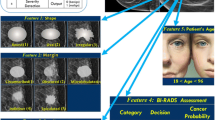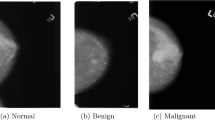Abstract
Timely and accurate Breast Cancer (BC) prediction allows healthcare providers and doctors to take suitable decisions to treat the patients. Thus, this study employed a strategy based on Deep Learning (DL) to diagnose BC. The study intends to cluster the BC data by the proposed Stochastic Self-Organizing Map (SOM) as it has the ability to process complex data. On the other hand, Enlarge C4.5 (E-C4.5) algorithm is introduced to predict the BC cases based on the clustered outcomes. The BC dataset is loaded and pre-processing is performed where dimensionality reduction is executed to select only the relevant features for clustering. This process eases the clustering. Then, clustering is undertaken by the proposed Stochastic Self-Organizing Map. Here, all the identical data are grouped as clusters which make it easy for prediction. Followed by this, Breast Cancer is predicted by the proposed Enlarge-C4.5 algorithm. After this, the predicted results are analysed by comparative analysis through the four standard performance metrics. This analysis is significant as it shows the degree to which the introduced techniques are effective than the existing techniques. The histogram, correlation map, confusion matrix and clustering results are also discussed clearly. The analytical outcomes explore that the proposed methods are effective than the conventional methods as the proposed method shows a high accuracy rate, precision rate, recall rate and F1-score rate. The misinterpretation rate is also found to be minimum on implementing the proposed method, which is confirmed through the confusion matrix. The proposed method also determines the malignant and benign counts.









Similar content being viewed by others
References
Aavula R, Bhramaramba R (2021) Towards a framework for breast cancer prognosis: risk assessment. In: ICCCE 2020. Springer, pp 1517–1533
Abdulkareem SA, Abdulkareem ZO (2021) An evaluation of the Wisconsin Breast Cancer Dataset using Ensemble Classifiers and RFE Feature Selection Technique. International Journal of Sciences: Basic and Applied Research (IJSBAR) 55(2):67–80
Arefan D, Mohamed AA, Berg WA, Zuley ML, Sumkin JH, Wu S (2020) Deep learning modeling using normal mammograms for predicting breast cancer risk. Med Phys 47:110–118
Baloni P, Dinalankara W, Earls JC, Knijnenburg TA, Geman D, Marchionni L et al (2021) Identifying personalized metabolic signatures in breast cancer. Metabolites 11:20
Begum A, Kumar R (2021) Review of chronic inflammation and long term effects on health using machine learning algorithms. Int J Comput Sci Eng 9(6):70–76. https://doi.org/10.26438/ijcse/v9i6.7076
Benhammou Y, Achchab B, Herrera F, Tabik S (2020) BreakHis based breast cancer automatic diagnosis using deep learning: taxonomy, survey and insights. Neurocomputing 375:9–24
Esteva A, Robicquet A, Ramsundar B, Kuleshov V, DePristo M, Chou K et al (2019) A guide to deep learning in healthcare. Nat Med 25:24–29
Ghiasi MM, Zendehboudi S (2021) Application of decision tree-based ensemble learning in the classification of breast cancer. Comput Biol Med 128:104089
Ghosh SK, Mitra A, Ghosh A (2021) A novel intuitionistic fuzzy soft set entrenched mammogram segmentation under multigranulation approximation for breast cancer detection in early stages. Expert Syst Appl 169:114329
Gupta P, Garg S (2020) Breast cancer prediction using varying parameters of machine learning models. Procedia Comput Sci 171:593–601
Hakkoum H, Idri A, Abnane I (2021) Assessing and comparing interpretability techniques for artificial neural networks breast cancer classication. Computer methods in biomechanics and biomedical engineering: imaging & visualization, pp 1–13
Herent P, Schmauch B, Jehanno P, Dehaene O, Saillard C, Balleyguier C et al (2019) Detection and characterization of MRI breast lesions using deep learning. Diagn Interv Imaging 100:219–225
Jaiswal A, Kumar R (2020) Review of machine learning algorithms in cancer prognosis and prediction. J All Res Educ Sci Methods 8(6):146–156
Kadam VJ, Jadhav SM, Vijayakumar K (2019) Breast cancer diagnosis using feature ensemble learning based on stacked sparse autoencoders and softmax regression. J Med Syst 43:1–11
Karthik S, Perumal RS, Mouli PC (2018) Breast cancer classification using deep neural networks. In: Knowledge computing and its applications. Springer, pp 227–241
Khan S, Islam N, Jan Z, Din IU, Rodrigues JJC (2019) A novel deep learning based framework for the detection and classification of breast cancer using transfer learning. Pattern Recognit Lett 125:1–6
Kumar V, Mishra BK, Mazzara M, Thanh DN, Verma A (2020) Prediction of malignant and benign breast cancer: a data mining approach in healthcare applications. In: Advances in data science and management. Springer, pp 435–442
Kumari M, Singh V (2018) Breast cancer prediction system. Procedia Comput Sci 132:371–376
Meenalochini G, Ramkumar S (2021) Survey of machine learning algorithms for breast cancer detection using mammogram images. Mater Today: Proc 37:2738–2743
Men K, Zhang T, Chen X, Chen B, Tang Y, Wang S et al (2018) Fully automatic and robust segmentation of the clinical target volume for radiotherapy of breast cancer using big data and deep learning. Physica Med 50:13–19
Nawaz M, Sewissy AA, Soliman THA (2018) Multi-class breast cancer classification using deep learning convolutional neural network. Int J Adv Comput Sci Appl 9:316–332
Ravi V, Alazab M, Srinivasan S, Arunachalam A, Soman PK (2021) Adversarial defense: DGA-based botnets and DNS homographs detection through integrated deep learning. IEEE Trans Eng Manage:1–18. https://doi.org/10.1109/TEM.2021.3059664
Saha M, Chakraborty C (2018) Her2net: a deep framework for semantic segmentation and classification of cell membranes and nuclei in breast cancer evaluation. IEEE Trans Image Process 27:2189–2200
Shaikh K, Krishnan S, Thanki R (2020) Artificial intelligence in breast cancer early detection and diagnosis. Springer, New York
Shukla N, Hagenbuchner M, Win KT, Yang J (2018) Breast cancer data analysis for survivability studies and prediction. Comput Methods Programs Biomed 155:199–208
Singh A, Dwivedi RK, Kumar R (2021) A survey of lung cancer detection using machine learning techniques for improving classification performance. World J Eng Res Technol 7(4):149–161
Sun D, Wang M, Li A (2018) A multimodal deep neural network for human breast cancer prognosis prediction by integrating multi-dimensional data. IEEE/ACM Trans Comput Biol Bioinf 16:841–850
Wolberg WH, Street WN, Mangasarian OL Breast Cancer Wisconsin (Diagnostic) Data Set creators. University of Wisconsin, Clinical Sciences Center, Madison. https://archive.ics.uci.edu/ml/datasets/Breast+Cancer+Wisconsin+(Diagnostic)
Wu J, Hicks C (2021) Breast cancer type classification using machine learning. J Pers Med 11:61
Xie J, Wu Z, Xia Q, Ding L, Fujita H (2020) The differential feature detection and the clustering analysis to breast cancers. In: International conference on industrial, engineering and other applications of applied intelligent systems, pp 457–469
Zhang D, Zou L, Zhou X, He F (2018) Integrating feature selection and feature extraction methods with deep learning to predict clinical outcome of breast cancer. IEEE Access 6:28936–28944
Zhang X, Zhang Y, Zhang Q, Ren Y, Qiu T, Ma J et al (2019) Extracting comprehensive clinical information for breast cancer using deep learning methods. Int J Med Informatics 132:103985
Zhang Y-D, Satapathy SC, Guttery DS, Górriz JM, Wang S-H (2021) Improved breast cancer classification through combining graph convolutional network and convolutional neural network. Inf Process Manag 58:102439
Author information
Authors and Affiliations
Corresponding author
Ethics declarations
Conflict of interest
The authors declare that they have no conflict of interest.
Data sharing not applicable to this article as no datasets were generated or analyzed during the current study.
Additional information
Publisher’s note
Springer Nature remains neutral with regard to jurisdictional claims in published maps and institutional affiliations.
Rights and permissions
Springer Nature or its licensor (e.g. a society or other partner) holds exclusive rights to this article under a publishing agreement with the author(s) or other rightsholder(s); author self-archiving of the accepted manuscript version of this article is solely governed by the terms of such publishing agreement and applicable law.
About this article
Cite this article
Jaiswal, A., Kumar, R. Breast cancer diagnosis using Stochastic Self-Organizing Map and Enlarge C4.5. Multimed Tools Appl 82, 18059–18076 (2023). https://doi.org/10.1007/s11042-022-14265-1
Received:
Revised:
Accepted:
Published:
Issue Date:
DOI: https://doi.org/10.1007/s11042-022-14265-1




